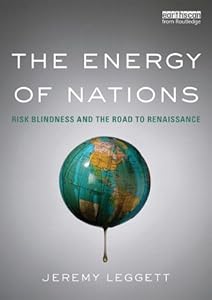Page added on September 26, 2013
The Energy Of Nations

Jeremy Leggett has a new book out called “The Energy Of Nations” on “Risk Blindness and the Road to Renaissance”. The preface and first chapter are here (pdf).
Jeremy also has some news article posted – Why governments are blind to fossil fuel energy risk and A grim future if our oil-dependent society refuses to change.
Systemic risks of oil supply, climate shock and financial collapse threaten tomorrow’s economies and mean businesses and policy makers face huge challenges in fuelling tomorrow’s world.Jeremy Leggett gives a personal testimony of the dangers often ignored and incompletely understood – a journey through the human mind, the institutionalization of denial, and the reasons civilizations fail. It is also an account of tantalizing hope, because mobiliizing renewables and redeploying energy funding can soften the crash of modern capitalism and set us on a road to renaissance.
4 Comments on "The Energy Of Nations"


J-Gav on Thu, 26th Sep 2013 1:27 pm
“Softening the crash” is indeed about as good as we can reasonably hope to do … and even that will take a huge shift which has hardly even begun.
bobinget on Thu, 26th Sep 2013 4:20 pm
Speaking of which, a most disturbing news item crossed a few days ago.
http://www.scmp.com/business/commodities/article/1316393/coal-conversion-concerns-piling
Here’s a taste.
Mainland energy companies are stepping up their investment in projects to turn coal into liquid fuel, chemicals and natural gas, as tumbling coal prices caused by oversupply make such processes more lucrative.
They had already been experimenting with such projects as a way to meeting rising demand for energy and chemicals, since the mainland is rich in coal but poor in oil and gas.
Now, with prices of imported oil and gas staying high, replacing them with cheap domestic coal – particularly coal from remote regions – to produce downstream fuel and industrial chemicals makes economic sense.
However, analysts warn, concerns about the depletion of scarce water resources in most of the mainland’s coal-rich regions and carbon dioxide emissions from such water-intensive and emission-heavy projects mean they face big environmental challenges and uncertain returns.
China Coal Energy, the listed unit of the mainland’s second-largest coal producer China National Coal, said late last month that its budget for coal-to-chemical projects this year – 17.4 billion yuan (HK$21.9 billion) – had for the first time surpassed the 3.2 billion yuan set aside for developing coal mines.
Its enthusiasm for such projects, to add value to coal and reduce the impact of volatile coal prices on its bottom line, is shared by bigger rival China Shenhua Energy, which plans to buy parent Shenhua Group’s coal-to-liquid fuel and chemicals businesses.
The liquid fuel includes petrol and diesel, while the chemicals include polypropylene and naphtha, raw materials for making plastics and fabrics. These are traditionally derived from crude oil.
The [gas] plan effectively shifts carbon dioxide emissions to [China’s] west UBS ANALYSTS
The prospect of using technology to exploit ample domestic coal resources has also caught the attention of non-coal energy firms. China Petroleum & Chemical (Sinopec), the nation’s second-largest oil and gas producer, said late last month that a coal-to-gas conversion project that would pipe gas from the coal-rich Xinjiang Uygur autonomous region to Guangdong and Zhejiang provinces had been approved by Beijing. Sinopec’s partners in the project, which it is leading, include seven other state-owned power and coal producers.
Coal gasification is the process of “manufacturing” natural gas, or methane, from coal. Coal is exposed to steam and air under high temperature and pressure, which produces gases consisting mostly of carbon monoxide and hydrogen. Such “synthetic gases” are further processed to make methane….
GregT on Thu, 26th Sep 2013 9:40 pm
Our so called leaders are doing everything possible to keep the ride going for as long as they can, when they should be applying the brakes.
I think the best hope people have, is to jump off of the train now, and hope that they don’t get too badly injured, and that they land as far away from the coming train wreck as possible.
Arthur on Fri, 27th Sep 2013 7:54 am
My preparations for the coming 12-24 months:
– 9 panels of 250 W on the sunny side of my roof, which will bring me 2250 kwh/year, just enough to cover my modest energy bill: fridge, washing machine once a week, and endless (internet) screen time. Cost: 6600 euro all in, incl. feed-in facilities.
– 12 m2 solar collector, probably high yield vacuum tube/heat pipes, vertical positioned against the garden wall and storage vessel. Direct air heating with ventilator. Each pipe of 150 cm and t vm diameter can generate more than 120 Watt. Cost: several thousand euro.
http://www.ecvv.com/product/1028865.html
– although I live in the middle of a city, I have 10 * 13 m garden, more than enough to cover a lot of food needs for two persons. Next spring the first round of tomatoes, cabbage, onions, etc are going yo be planted.
– longer term: invest 20k euro in building a glasshouse annex to my house for greenhouse effect, to capture additional heat and have 1-2 months extra to start rsising plants earlier in the season.
– first I am going to invest 120 euro in a Gerbing thermo wired vest, battery included, to test if I can bring down room temperature from 21 to 18 degrees Celcius and still feel comfortable.